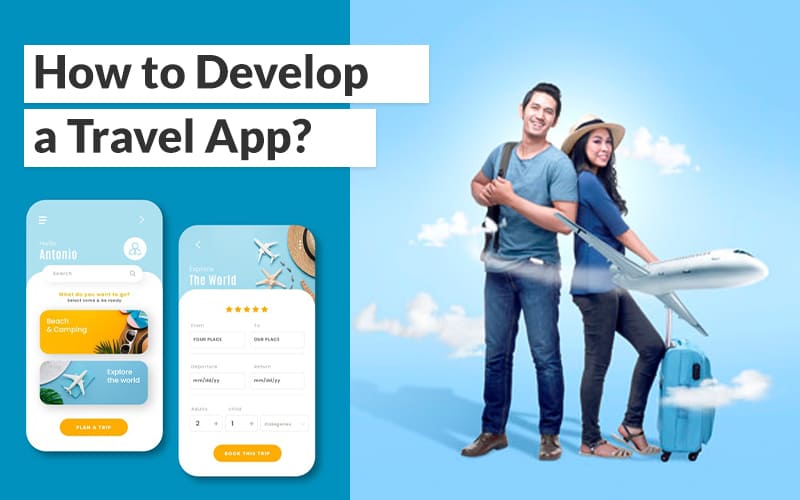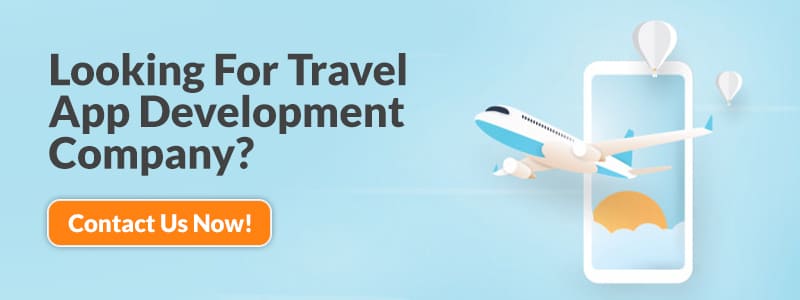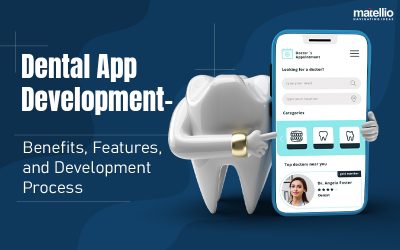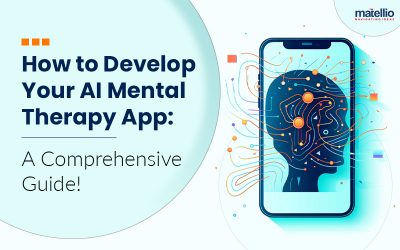How To Develop a Travel App?
The travel industry has witnessed significant digital penetration in the past few years. Today, this industry, one of the largest service industries, is growing through changing consumer behaviour and building on technologies that lead to new travel trends. Some of the most significant trends suggest that:
- An estimated 700 million people will make a booking online by 2023
- 83% of US adults want to book their trips online
- 72% of mobile bookings happen within 48 hours of last-minute Google searches that include the words ‘tonight’ and ‘today.’
- 82% of all travel bookings around the world took place without human interaction in 2018
- There are over 148 million travel bookings made annually
- 70% of all customers do their research on a smartphone
No wonder an increasing number of travel businesses are investing in travel app development to boost their sales and attract customers. If you are one of those, you are in the right place. Today, we are discussing the most straightforward process to develop a travel app.
Recommended Read : How to Develop a Real-Time Public Transport App?
Let’s get started.
How To Develop a Travel App?
Step 1: Discovery Phase with Expert Consultation
The first step to kickstart your travel app development is business consultants, where Matellio’s expert team works with you to make sure a unique project. This would include business and technology consultation where our professionals will analyze your app idea, study your market, and outline the app deliverables accordingly.
Once your business aspects are covered, the Matellio team will work with you on the technical aspects such as:
Platform for Mobile App Development
Generally, travel business owners would have the following options to choose from:
- Native application development: Native apps are tailored for only iOS or Android, etc. This application development mode is preferable if your target audience is inclined towards one of the platforms only. Some of the benefits that native apps offer include:
- High-end performance
- Better security
- More interactive and intuitive
- Accessibility to full features of the devices
- Lesser bugs
- Cross-platform application development: Cross-platform mobile applications support more than one platform. They are compatible with iOS and Android to deliver a seamless experience across both. Some of the benefits that cross-platform apps offer include:
-
- Maximum exposure for the target audience
- Native-like experience
- Cost-effective to develop due to reusable code
- Easier deployment and maintenance
- Better cloud integration
- Short time-to-market and faster customization
- Design uniformity
- Direct access to plugins
Choosing Team for Travel App Development
Once you have made your mind about the platform you want to build your app, the next step is to select the team based on it. Your team should ideally include the following professionals:
- Project manager
- Native or Cross-platform app developers
- UI/ UX experts
- QA and testing professionals
- Digital marketing professionals (if you want to ensure your app reaches the target audience)
At Matellio, we follow strict client-centric methodologies that ensure that you interact with your project managers and have a team that adds value to your project. With clearly defined communication models and escalation matrix, we enable you to stay in constant touch with your team.
Finalize the App Development Technology Stack
The technology stack is the building block of your application. Although your team will assist you in choosing the most appropriate technology for your travel app. It is required to ensure that you choose the latest in the market and the one that also helps you build upon it in future. Some of the knows frameworks and tools are listed here:
- Native App Development:
- Swift (iOS development framework)
- Android Studio (Android development framework)
- Cross-platform app development:
- React Native (Cross-platform development framework)
- Ionic (Cross-platform development framework)
- Xamarin (Cross-platform development framework)
- Data analytics tools
- Python
- Java
- Amazon EC2
- Amazon S3
- Kafka
- Scala
- Amazon VPC
- Amazon EMR
- Apache Impala
- Utilities
- Elastic Search
- DevOps tools
- Chef
- AWS CloudFormation
- Database
- Aerospike
- MongoDB
- Cassandra
- HBase
- MySQL
- Postgres
Step 2: Architecture for Travel App
Once you have gone through the Discovery phase, the fundamental part of holiday planner travel app development begins. It is known and architecture and UI/ UX development, with architecture being the first stage.
Mobile app architecture is a set of techniques and patterns, following which the mobile app is structured. These aspects of the mobile app, keeping the app owner’s requirements and industry standards in mind.
An excellent mobile app architecture ensures that all the components of the app work seamlessly. Satisfying these aids mobile app development teams to ensure quick time-to-market and makes future maintenance easier. A wisely chosen architecture with the right technology helps solve the most complex business problems effectively.
There are three levels to mobile architecture:
- Presentation Layer
- Business Layer
- Data Access Layer
Step 3: UI/ UX Development
Travel app experiences closely determine the traveller’s experience. You can either deliver a seamless experience that will keep travellers coming back to you back and forth, or ruin it forever that takes them away from you once and for all. There is no middle ground.
In order to ensure that your travel app creates the ultimate user experience, app professionals at Matellio keep the following aspects in focus:
- Transparency: Make sure your app doesn’t surprise users with hidden costs. Communicate as clearly as possible to ensure success.
- Minimalism: Users are highly demanding. They use a display with limited area and consistently try to grasp information while doing something else they love apart from travelling. Ensure the screen delivers the correct information even in this scenario by following the minimalistic design approach.
- Easy Navigations: Don’t make using the app a science for the users. Matellio’s UI/ UX experts ensure that:
-
- While searching, users can discover the spot-on results
- The search bar is visible, fast, and easier to access
- Personalized results are there to help users
- Data is presented appealingly and not cluttered.
- Speed and Agility: Users are looking for solutions to their problems. No one wants to use an app that magnifies those problems. Make sure the results are rendered fast and easy to the users.
Step 4: Travel App Development
Travel app development is done according to an easy process, where the requirements of each user category are taken into account. The entire app development process is broken into three phases:
Phase 1: Travel App Development for Travelers
- User Sign up/ Login: Easy user signs up and signs in using email or social login options.
- Avail Deals: Users can browse through deals and discounts available on the app and get information about them. Once convinced, they’ll be able to book via the same window.
- Holiday Package: Users can check for available holiday packages & avail exclusive deals as a part of the holiday planner travel app.
- Finding or booking a cab: This feature will enable the users to find the cab in a new place and navigate around easy across the location.
- Find vendors: This will help users find vendors for specific services in the travel location and gain more knowledge about the location. They can also contact the vendors directly via the app.
- Payment: Integrated and secure payment options to ensure that users can pay hassle-free, regardless of the currency or required payment guidelines in the travel destination.
- GPS Integration: GPS Integration would make it easier for the users to navigate in an unknown location.
- Bookmark or Shortlist: With this feature, users will shortlist the destinations or vendors they like.
- Search: Users will search for their requirements in a snap of fingers with this feature.
- Travel Guide: Simply as users pinpoint the source and destination, they will be able to gather estimated cost, and step by step travel guides.
- Reviews: Users shall be able to share reviews for their vendors or services they like.
- Categories: You can use your country states/cities as categories, and the app will divide the contents according to the categories. It will help the users to find out places quickly.
- Multi-language Support: This will enable users to view content in their preferred language.
Phase 2: Travel App Development for Businesses
- Package Management: Vendors can offer and customize packages based on their strategies using the agency-facing application.
- Listed Destination: Business can list or delist locations from their service geographies and manage it based on their current status.
- Manage Payments: Business can receive payments or request them using the agency-facing applications.
- Bookings Management: Vendors can manage bookings like hotels, flights, etc. And send booking confirmation to the users when needed.
- Editing the Packages: The agency can edit the packages they have provided on the application, like their price and deals.
- Analytics: The Agency reviews the report generated, which generally tells them about the number of booking made for the hotel, flights, or both combined and how many destinations are the most common for their users.
Phase 3: Admin Panel Development
- Managing Requests: Admins can check all the requests made on the system and take relevant action based on the requirements.
- Manage Advertising and Promotions: Admins can manage tailored advertisements and promotional content running across the application.
- Manage Users: Admins can manage users from both the categories and take required actions.
- Managing Vendors: Easily manage the vendors and service providers registered on the app and access information about them to offer right solutions when needed.
- Dashboard: Access statistical real-time data of users, places, blogs, featured contents, notifications, categories etc.
- Upload, Edit, Delete: Control every content (places & blogs) with a real-time preview feature.
Step 5: Quality Assurance and Launch
This is one of the most crucial aspects of travel app development. Travel apps don’t cater to a specific group of people or people of a single age group. One app needs to accommodate the requirements of a global audience- with multiple currencies, time and date formats, languages, preferences and more. A glitch in the performance of these apps doesn’t just hinder the travellers’ experience, but also hundreds of businesses registered on the apps are affected.
Quality assurance and testing services for the travel industry ensures that travel apps offer the features and functionality with the desired output to travels and vendors alike.
Types of Testing for Travel Apps Followed at Matellio
- Connectivity Testing: More and more people are booking smooth travelling experiences using travel apps. With an increasing number of brands creating similar applications on connected devices, ensuring that your app works on all networks under varying conditions.
- Accessibility Testing: With the broad audience that travel apps are made for, accessibility is essential to be taken care of. Accessibility testing ensures that the travel app you launch is usable and functional across multiple access points, including aspects like alt-text, incorporating keyboard-only navigation, colour contrast ratios, and video closed captions, etc.
- Globalization Testing: Globalization testing is imperative to target an audience as broad as that for travel apps. Globalization testing ensures that your app is usable and flexible for users across geographies, cultures, and languages in addition to functioning correctly. For this, an understanding of various user bases is a must.
Once the Quality Assurance is complete, the app is due for the business owner’s approval. Once you approve, the app is made life for the users to enjoy.
Is Your Travel App Idea Ready to Slay the Market?
What are you waiting for? It’s the right time to find a travel app development company like Matellio and get started to transform your idea into a reality. Our team is versed with similar projects and offers travel solutions that cater to the need of the hour. Some of the most popular choices of solutions include:
- Custom Travel and Hospitality Software and Apps
- AI-enabled Travel and Hospitality Software
- Blockchain-Enabled Travel and Hospitality Solutions
- IoT-based Travel and Hospitality Software
- Big Data Travel and Hospitality Solutions
Our travel and hospitality software such as Trip of Things, EnnQ travels, besides many others, speaks volumes about our expertise. To start with, let’s assist you on a FREE 30-minute consultation call.
Read Also : How to Develop Bespoke Taxi Booking App Like Bolt & Uber?






